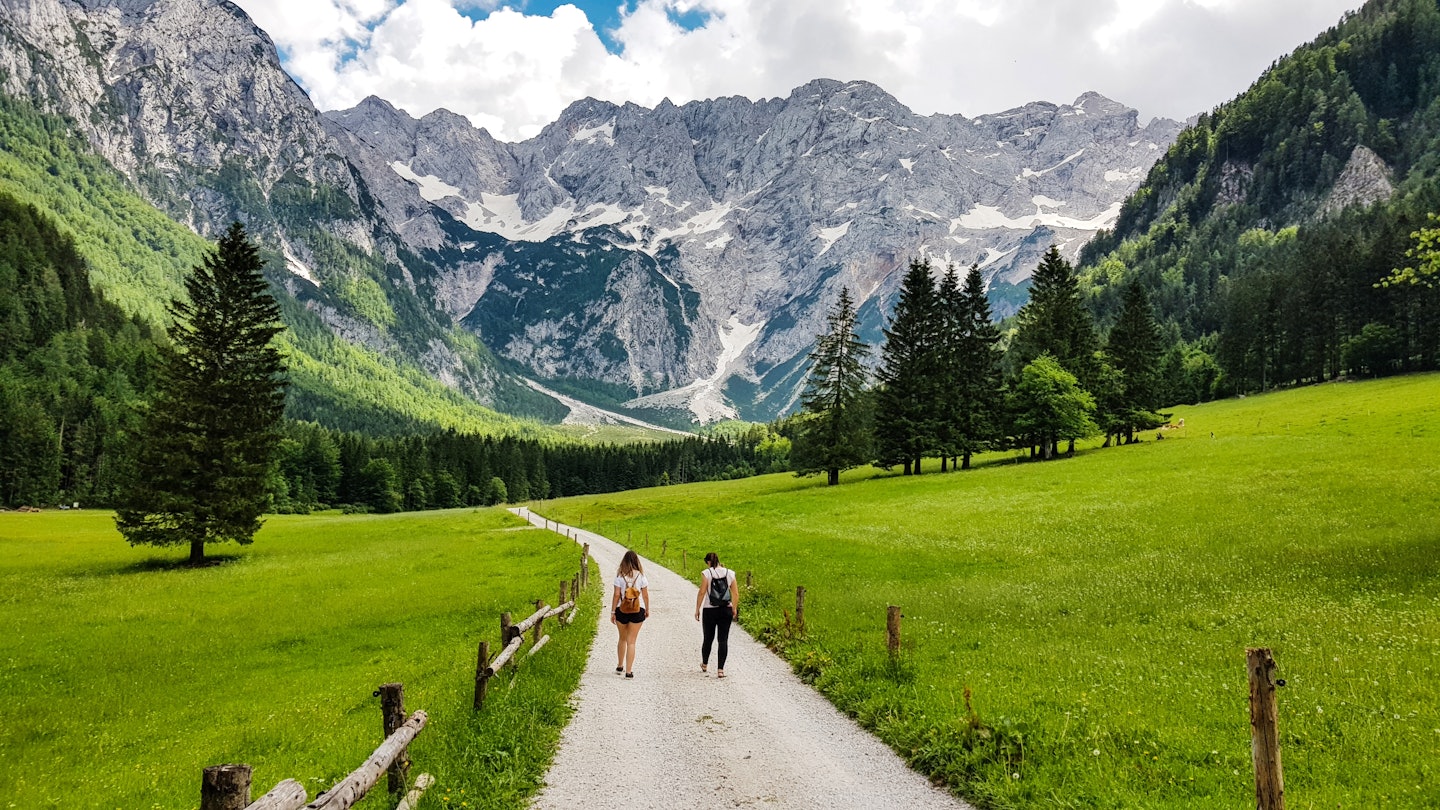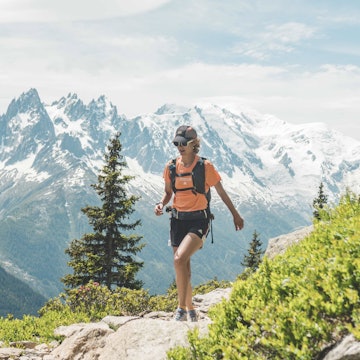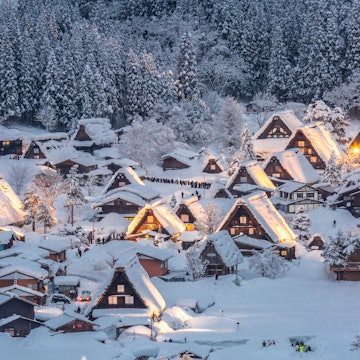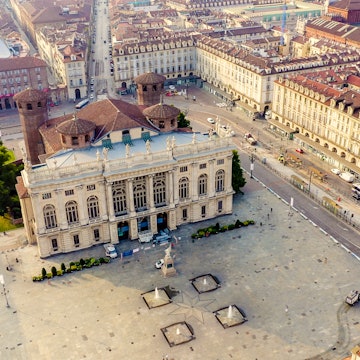

The Kamnik-Savinja Alps of Zgornje Jezersko, one of Slovenia's five mountain ranges © Marko Klaric / EyeEm / Getty
Slovenia, which calls itself “the Sunny Side of the Alps,” is a haven for hiking. That’s a surprise to some, but it’s not revelatory. This bantam-sized Central European country, smaller than New Jersey and half of Switzerland, has five mountain ranges with more than 300 peaks over 2000 meters. Within the nation’s 20,000 square kilometers, there are 15,000 kilometers of trails. The paths drop you next to glacial lakes, emerald rivers and the Adriatic coast.
If the country’s credentials are still in question, these classic, long-distance hikes will put the matter to rest. They combine Slovenia’s strengths: close-knit communities, simple and stellar cuisine (Slovenia was Europe’s Gastronomic Region for 2021) and its passion for responsible tourism. Though there is great year-round trekking here, June to October are the peak months when the weather is more stable and you can count on open mountain huts.
Here's a handy guide to preparing for your trek along with the top five best long-haul hikes throughout Slovenia.
Where to stay on your trek: Slovenia's mountain huts
For many, the planning portion of a trekking or mountaineering expedition can be more daunting than the outing itself. In Slovenia, that task is made easier with a well-developed system of mountain huts that service many of the routes included here. As is the case with any hike, the rule of thumb is to book ahead when possible. Most of the lodges have websites, email addresses and phone numbers. Camping, it should be noted, is not permitted outside of designated campsites. Be aware that many lodgings and huts close from late October to May. Plan your trip from June to October. For more extreme excursions: In the Slovenian highlands, in addition to mountain huts, there is a fairly extensive network of mountain bivouacs (shelters), called bivaks here. Some mountain huts also have unattended winter rooms that are open all year round.
7 expert tips for tackling your first multi-day hike

Eating well on your trek is easy
Slovenes — in the mountains and otherwise — eat well, and locally. Sausages, cheese, goulash, game and homegrown vegetables are typical. Many of the accommodations and huts serve food to lodgers for both dinner and breakfast. Along the trail, one should feel secure about passing through towns to stock up on lunch and mid-trek rations.
What you pack matters, especially as the trails get more challenging
Within Slovenia, it is strongly recommended to carry helmets and via ferrata equipment – especially on hikes over 2000 meters in elevation. The Alpine Association of Slovenia shares a checklist of safety tips, equipment and hiking hints. “It all depends on the time of year you are hiking, but it is best to have the equipment you might need with you,” says Matija Klanjšček, a Slovenian alpinism instructor who works with Visit GoodPlace, a Ljubljana-based adventure tourism operator. “I generally keep a helmet with me and keep an eye on the trail difficulty. Easy, moderate and hard routes are depicted on maps as full, dashed and dotted lines, respectively.”
How to pack like a pro for a backpacking trip

Juliana Trail for jaw-dropping panoramas
Best Hike for Great Views
168 miles (270km), 16 days
Though just launched in 2019, the Juliana Trail feels as if it was always part of Slovenia’s classic hikes’ canon. The route provides trekkers with continual front-row views of the Julian Alps, which dominate the country’s northwestern corner, as it circumnavigates Triglav National Park. Stage-by-stage directions make the relatively flat, circular hike simple to plan and caters to all skill levels and keeps Slovenia’s highest peak, the 9396-foot (2,864 m) Mount Triglav, in its sights. Expect stunning villages, jaw-dropping panoramas and inviting mountain towns like Bovec, which is wedged between peaks, sits on the Soča River, and boasts some of the continent’s best kayaking and rafting. Trekkers can choose between mountain lodgings, camping and swanky hotels along the way. All of these accommodations service beautiful alpine sites like the famous, tectonic and glacial Lake Bohinj, where ordering trout and trying a local draft beer is a necessity. At the edge of Lake Bled, perhaps the most iconic photo-op in the country, the Bled Castle hangs from a bluff overlooking the Church of the Assumption, which is built atop 12th-century foundations.
There's a new way to explore Slovenia sustainably
Walk of Peace for a hike through history
Best Hike for History
137 miles (220km), 11 days
The Walk of Peace starts in Log pod Mangartom – a village nestled in the Julian Alps – and ends in the Adriatic city of Trieste. But this isn’t just a thru-hike; it exemplifies Slovenia’s responsible tourism philosophy. The 137-mile trail, which follows the WWI frontline between Italy and Slovenia (then part of Austro-Hungary), is a historically themed itinerary for independent travelers to learn about culture while walking from locale to locale. (The main path can be extended an additional 174 miles with alternate loops and routes provided on the site.)
Like with many Slovenian routes, Walk of Peace trekkers stay in wonderful lodges and huts and visit remote communities. However, the trail’s goal and offerings are unique. Hikers will investigate preserved bunkers, memorial churches, trenches and museums from the Great War while gaining a new perspective about conditions during the conflict. The Kobarid Museum, in the town of Kobarid, displays a wide array of artifacts, artillery, photographs and interactive exhibits that bring World War I to life. The hope is the region’s immense beauty combined with history will encourage more tolerance for others.

Slovenian Mountain Trail for adventure and adrenaline
Best Long-Distance Hike
383 miles (617km), 28-35 days
Established in 1953, the Slovenian Mountain Trail is the country’s longest trek. Starting in Maribor, in the Pohorje Hills on the country’s eastern side, the route rambles along the nation’s northern border with Austria and the Kamnik–Savinja and Karavanke Alps, and turns south at the Juliana Alps. Along the way, there is an abundance of mountain huts (around 50 spread across the approximately 30 stages). Make sure to book your lodging ahead of time when possible, and plan for a vast array of adventure, adrenaline and educational activities and for every trekker and skill level. In the town of Mojstrana, visit the Slovenian Alpine Museum, which is a great place to learn skills and the history of mountaineering. Make sure to pack a helmet to scale the via ferrata route and summit Mount Triglav, the country’s highest peak. From there, you cross the ethereally turquoise Soča River on the way through the Karst region to the coast.

Via Alpina: Red and Purple trails for the challenge and reward
Best Challenging Trek
211 miles (340km), 17-20 days
Slovenia possesses sizable portions of two trails from the Via Alpina network, which has five color-coded routes stretching across the eight countries of the Alps. The trails provide classic European hiking: often challenging, sometimes long and steep and typically well marked. In Slovenia, lodges, hotels and mountain huts service the routes (most serving food) and make it convenient to hike approximately 10km (six miles) per day on the Purple Trail and around 17km per day on the Red Trail. In simple terms, think of Purple as west to east and Red Trail as south to north.
Slovenia’s Purple Trail (10 stages, approximately seven days) begins near Mount Triglav’s base and hikes from the Julian Alps across the Kamnik–Savinja and Karavanke Alps into Austria. Take a day to summit Triglav, Slovenia’s highest peak, before setting out. You’ll need a helmet and harness (via ferrata gear), but the views aren’t just rewarding, they are necessary. As the lore goes, you are not a real Slovene until you climb the country’s tallest point. The Red Trail, which forms the overall backbone of the entire Via Dinarica network, spends part or all of 15 stages (around 10 days) in Slovenia. The route starts in Trieste, Italy, before heading into the Julian Alps and crossing country lines near the junction between Slovenia, Austria and Italy. Along the way, you’ll pass two Unesco Heritage Sites: the Škocjan Caves and the town of Idrija, which has the planet’s second-largest mercury mine. In order to guarantee that lodgings are open – and for stable weather generally – it is best to hike from June to October.
Everything you need to know about Interrail passes in Europe

Via Dinarica for the pace and ease
Best for Authentic Mountain Culture
94 miles (152km), 7 days
The Via Dinarica Trail took the Via Alpina (see above) concept and transferred it south and east across the Dinaric Alps, which sprawl over the countries of the Western Balkans. The trailhead for the entire Via Dinarica route is the Nanos Plateau in Slovenia’s southwestern Karst region. Continuing eastward, the country’s portion of the path ends after reaching the tiny municipality of Babno Polje on the Croatian border.
Trekkers should be ready for a slightly more backcountry feel to the hiking experience in the Balkans. Huts, hostels and family-run hotels are still the accommodations found, but they often come with a slower and easier – and noticeably less expensive – pace. Highlights along the route include the Predjama Castle, the mammoth Postojna Cave and Adriatic views from the top of the 5,892-foot Snežnik Mountain.
You might also like:
Slovenia's new green cycling tour takes you to wineries and national parks
Treat yourself to a chocolate massage at this luxurious glamping village in Slovenia
Six reasons to visit Slovenia, a gem at the heart of Europe
Slovenia is on our 2022 Best of Travel list. For more stories from some of the world’s most exciting destinations click here.
Safety recommendations and restrictions during a pandemic can change rapidly. Lonely Planet recommends that travelers always check with local authorities for up-to-date guidance before traveling during COVID-19.
















